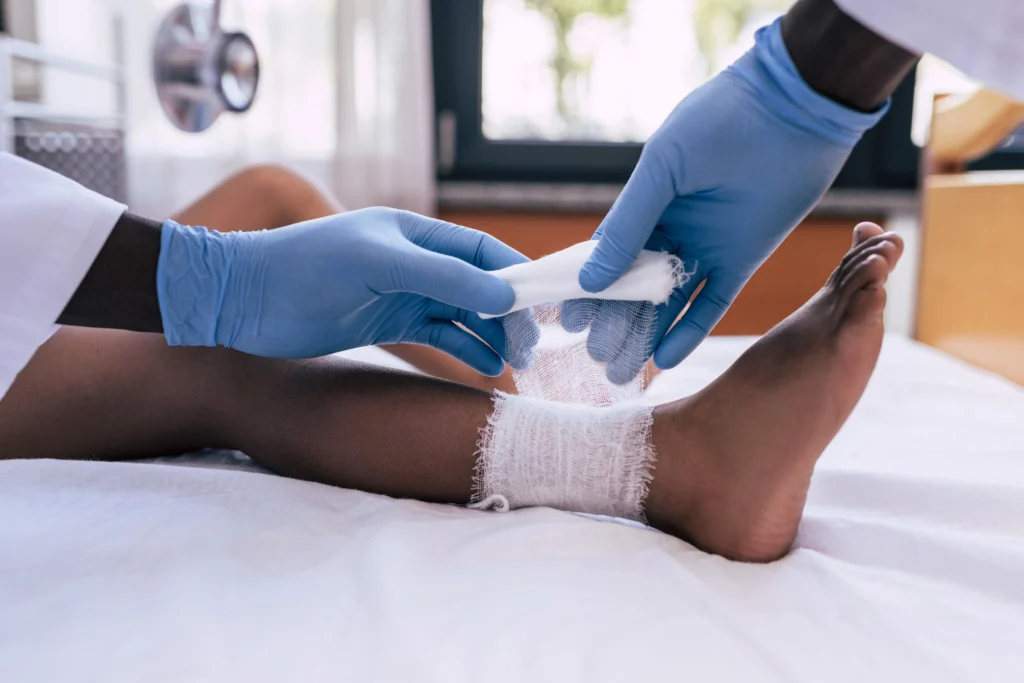Author's details
- Hakim A Abubakre
- BA (Hons) International Business Management, Msc Digital Marketing.
Reviewer's details
- Dr. Khashau Eleburuike
- MBBS (Ilorin) MSc. Global Health Karolinska Institute.
- Resident doctor in family medicine in Northen Sweden.

- Date Published: 2025-09-23
- Date Updated: 2025-09-23
Fractures in Children
What is a fracture?
A fracture is when a child’s bone breaks or cracks after force greater than the bone can handle. Children’s bones are softer and more flexible than adults’, so they may bend, crack, or break more easily.
Fractures are common in children and often happen because of falls, road accidents, sports injuries, or domestic accidents. Sadly, in some cases, fractures may be due to physical abuse.
Common types of fractures in children
- Greenstick fracture – the bone bends and cracks but does not break completely.
- Buckle fracture – the bone bends instead of breaking fully.
- Growth plate fracture – happens in the growing part of a child’s bone.
- Avulsion fracture – when a tendon or ligament pulls off a piece of bone.
- Stress fracture – a tiny crack in the bone, often from repeated stress.
- Comminuted fracture – the bone breaks into several pieces.
- Compound fracture – the bone pierces through the skin.
Commonly broken bones in children include collarbone, arm, elbow, wrist, hand, hip, thighbone, knee, leg, foot, or ankle.
Warning signs and symptoms
- Pain when touching or moving the injured area
- Swelling, redness, or bruising
- The limb looks bent or deformed
- Trouble moving or putting weight on the injured part
- Warmth around the area
- Numbness or tingling
- In severe cases, the bone may pierce the skin
First aid and self-care
If you suspect a fracture:
- Keep the child calm and limit movement.
- Immobilize the limb with a firm object (like wood or cardboard) tied gently.
- Stop bleeding with clean cloth if needed.
- Do not try to straighten the bone yourself.
- Go to the nearest health facility quickly.
While waiting for care:
- Give pain medicine only as advised by a health professional.
- Raise the injured limb on pillows to reduce swelling.
- Apply a wrapped ice pack (not directly on skin) for 10–15 minutes every 2–3 hours.
- Keep splints and casts dry and clean.
- Do not allow the child to scratch inside or cut the cast.
- Encourage rest and healthy eating with foods rich in calcium and vitamin D (milk, fish, eggs, green leafy vegetables).
When to seek urgent medical help
Take your child to a hospital immediately if:
- The bone is sticking out of the skin
- The limb looks deformed or cannot move
- There is heavy bleeding
- The injury involves the spine, neck, hip, or thighbone
- The injured area is blue, cold, or numb
- Pain is severe or worsening despite medicine
- Swelling, pus, or fever suggests infection
Treatment at the hospital
- X-rays are usually done to confirm the fracture.
- Most fractures are treated with a cast or splint to keep the bone in place.
- Severe cases may need surgery with wires, plates, or rods.
- Children’s bones usually heal within 4–8 weeks, faster than in adults.
Prevention
- Ensure children eat foods rich in calcium and vitamin D or use supplements if advised.
- Encourage safe physical activities like walking, running, or jumping to strengthen bones.
- Make the home safe with stair gates and window guards.
- Supervise play, especially on playgrounds or near heights.
- Teach road safety and ensure children use seatbelts in cars.
- Encourage protective gear (helmets, pads) for cycling and sports.
- Teach safe ways to fall (bending arms and rolling rather than stretching them out).
- Always supervise young children when they use sharp objects.
Key messages for parents and caregivers
- Most fractures in children heal well with proper treatment.
- Avoid traditional bone setters – they may cause more harm.
- Seek hospital care early to prevent complications.
- Good nutrition, safe environments, and supervision help prevent fractures.
1. World Health Organization (WHO). Child injury prevention: overview. Geneva: WHO;
2021.
2. UNICEF. Childhood injuries in Africa: The silent epidemic. UNICEF Africa Regional Office,
2020.
3. Abdur-Rahman LO, et al. Challenges of pediatric trauma in sub-Saharan Africa. African
Journal of Paediatric Surgery. 2019;16(1):1-6.
4. Ogunlade SO, Alonge TO. Pediatric fractures in developing countries: peculiarities and
challenges. Journal of Orthopaedic Trauma. 2018;32(Suppl 1):S23-S27.
